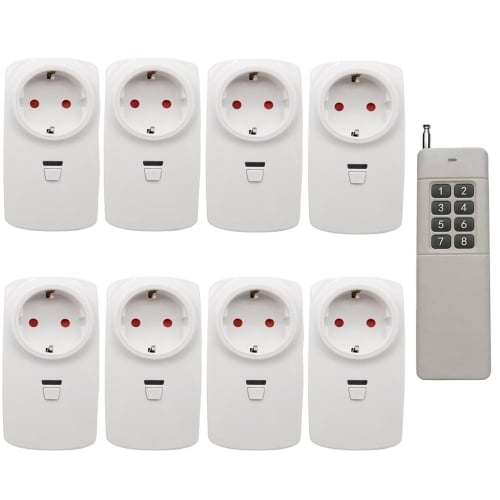They’re like that in this apartment we’re renting and I keep seeing them elsewhere. I don’t get it.
We got wm in Australia as well.
No one seemed to mention the important fact that UK and I think most Europe is a higher voltage than the US. Tom Scott as well as Technology Connections have some good videos on the whys and differences it causes.
Weird that you think anywhere other than North America has 110v electric
I think Japan has but literally every other country is 230
As on the Wikipedia map, you see it’s essentially North and Central America, Japan, Taiwan and some Pacific islands plus some countries where there is a mix of standards.

It’s also kind of misleading. This map labels North America as 115-120V like everyone always does, when in fact it’s ALSO a 240V system, it’s just that the “common” plug and the “typical” circuit don’t use it, they only use half of a center-tapped 240V line. So that’s the “standard” they choose to use to label the whole system.
But it’s kind of unfair. It’s 240V coming into the house just like everywhere else in the world, except you also get the choice for it to be 120V. Being split-phase makes it easy to run multiple 120V circuits with a minimum of wire and still allows 240V for high-wattage appliances on their own dedicated circuits. It’s actually a very clever system and basically every house is effectively supplied with both voltages. It’s often poorly utilized, yes, with a few practical limitations and a lot of limitations due to historical conventions, but as a technical design it’s really kind of the best of both worlds, and it could be utilized a lot more effectively than it is.
If I was allowed to have an outlet with two 120V sockets, and one 240V European-style socket, there’s no technical reason I could not safely do that in a single outlet box. I could choose to plug in whatever I want at either voltage as long as it wasn’t more than 15 amps. Of course code would never allow that, because we consider the higher voltage “more dangerous” but it’s always right there, across two opposite phase 120V lines. We’re just not allowed to use it, except for large electrical appliances like air conditioners and clothes dryers. It’s frustrating.
UK kettles use the standard 240V mains and it’s excellent. Under 2 minutes to boil 3 US Pints with a 3000 Watt kettle.
By that logic, Europe should be labeled with 400 V, as this is our split-phase voltage between two 230 V phases. It is commonly used to power ovens or water heaters. Industry and even some households have CEE connectors for movable heavy gear.
France used to have 110v too, it started to be phased out and replaced by the 220v in the 1950s.
Wow only 70 years ago
Not related but another surprising thing about our shared standards is that Sweden used to drive on the left until 1967. https://en.wikipedia.org/wiki/Dagen_H
Not positive but those could be GFI outlets.
That’s what I thought at first, but it’s literally every socket in this building both inside the apartment and outside in the hallways, and I keep seeing it in other buildings too.
Yup, they are the standard.
Would be fun to see some stories about you discovering things in the UK and how they are so different than in the US!
I am doing that, but I’m sort of putting them in appropriate threads. Otherwise I’d be writing a novel. Or I suppose creating a Flying Squid in Britain community. Maybe if I get less exhausted at some point I’ll post something long.
All modern wiring in the UK has every socket in the building connected via RCD (the more common name for GFCI outside America), but they’re usually in the main fusebox/consumer unit rather than individually per socket. These are just normal on/off switches for the convenience of being able to turn things on and off.
That’s a convenience we could all use, pretty crafty!
Saw a video of how the Japanese wire their panel’s and thought it was pretty genius.
https://www.youtube.com/watch?v=tqClY6PDCW0
Is it similar across the pond? Or is it like here where you can GFCI the panel through a breaker?
when any electricity leaks out (for example through your body) it switches off. the eu also has the same system, but its one switch for your entire house. the us also has this but only in bathrooms.
GFCI circuits are required by code around sinks and the like. Bathrooms, kitchens, utility wet rooms, etc.
You can relatively easily install them anywhere you want though.
These aren’t automatic switches, but other people explained the reasoning.
oh, according to electroboom they were gfci.
They’re connected to an RCD, as modern UK wiring has all sockets connected via an overall RCD in the fusebox, but the switches on the socket are just basic on/off switches.
UK household electricity is pretty spicy compared to many other places - it has more safety features as a result. (3 pinned fused plug, socket switches etc)
How is it more “spicy” than anywhere else in Europe?
The many other places is the US
And Japan, and Canada, and Mexico, and the majority of South America, and a handful of countries in Africa and the Middle East.
A lot of dodgey wiring.
In our defence, most of that is legacy from the post war rebuild (copper shortages etc). The modern regs are comparable or better than a lot of places.
There’s enough of the dodgy stuff around that it needs to be accounted for, but it’s being phased out as new stuff it built or renovated.
Do they have the wiring on the outside of the houses so it’s easier to repair?
I’ve heard in UK they tend to do such things.No, it’s usually buried in the wall behind the plasterboard. Although it is possible to use surface trunking. It’s quicker and therefore cheaper to use trunking with less making good afterwards

It was a joke on UK putting water pipes on the outside of their houses.
Making them sometimes freeze and burst in the winter, but it’s easier to repair. 😋Well duh, they freeze and burst in winter so they obviously need to be outside for easier repair! Think of the mess they would make if they were inside the walls.
I was mainly referring to almost all of the American continent(s), lots of Africa, China and a few other places too. I didn’t think I’d mentioned Europe.
The rest of Europe has 220V as well and they don’t have switches on their outlets.
I have been with 110v plenty of times used to wire houses in my youth. Been hit once with 220v knocked me on my ass for 3 days. I stopped being so cavalier after that I wish they had those outlets vs the midevil outlets the US has.
deleted by creator
the UK power grid is weird. mostly due to echoes of the war. used to be that, to save copper, the entire house and sometimes multiple houses on a street would be wired as one big loop of wire, no fuse box or anything. that’s where the individually fused and switched sockets come from. then, since it turned out to be quite a good idea for safety, they kept doing it.
The old Ring Circuit
This is the answer. When all sockets are connected to one big loop, there’s fuses in each socket to prevent a device from screwing with the whole system.
This isn’t strictly true. Most houses built between WWII and the '90s were built with sockets that didn’t have switches on them. It was only later safety regulations / suggestions that made the switches preferable.
Where I live was built in the late '80s right before switched sockets became more common. All the original sockets have no switch. Some in the kitchen have switches, but it’s clear these were added at a later date.
I’m not sure of the exact rulings and where and when a socket must have a switch, but you can still find switchless sockets for sale at the sorts of retailers who sell those sorts of things, so there are definitely places where those sockets are still allowed.
So that switch will trip like a breaker?
No - there’s fuses in the plugs themselves, the switch is largely for convenience and safety - if you want to unplug something broken and potentially live, it’s much safer to switch it off at the wall than risk a shock given the current limit is on the breaker is so high
Are folks able to replace the fuses without exposing live parts? I totally get the safety angle.
The screw to get to it is supposed to be on the side that would be facing the wall when plugged in so no
fuse is in plug and accessible only when plug is disconnected
it’s also a very weird thing because fuses are supposed to protect what is downstream of them. so effectively fuse in plug protects cord and appliance only, not the wires in the wall. there’s breaker box for this
It is safer for the fuse to be in the plug for those people who think they are electricians and end up causing house fires or bzzzt’ing themselves
Whoa. Thanks all!
eastern block solution to copper shortages was to wire houses with aluminum instead of copper. this avoided all that bizarre bullshit that brits do, and in principle it’s a good idea since aluminum is used for big time power distribution as well. this worked pretty well until it was noticed that under some conditions hot spots can form on connections over time, requiring replacement of connectors. it’s still legal to use aluminum wires in some places, but copper is more common now
Why are people saying this?
I’ve lived in multiple UK houses and never once seen a socket with a fuse. Are you saying this was change way way back in the day?
All houses have fuse boxes (which then got upgraded to circuit breakers). Not one fuses in sockets. Would be a fucking nightmare to take the socket off and change a fuse.
sloppy wording, i meant “switched sockets and fused plugs”.
The fuse is actually in the UK plug (the big brick-like thing with the wire on it), not the socket. But yes, it’s a thing, and most of the rest of the world considers it overkill. Also a lot of cheap junky equipment (ironically the stuff where you’d most want the fuse) omits the fuse in the plug, go figure.
Yea I know, I’ve wired a plug.
Never seen a fuse in a socket though. That comment is completely wrong and yet it’s the most up voted reply.
Never seen a house without a fuse box either.
No fuses in the switch box though, it’s a box of circuits breakers
Yea I know, I said that.
People still call them fuse boxes though.
The used to be - I had a flat that used an old style fused breaker. Fun times trying to replace a fuse when it had blown…
Lol yeah can only imagine what playing ‘hunt the bad device’ would’ve been like back when those boxes had actual fuses on them. (That’s the game where the main circuit breaker gets tripped and you have to figure out first what ring it’s on, and then which specific item is tripping it)
Didn’t the uk used to have appliances without plugs that you’d need to wire yourself If inrecalling that Tom Scott video correctly
When I bought the apartment I’m living in, the previous owner had refused all modernisation, even legal ones (he had mental problems), so the appartment had the original 1 hot wire going everywhere, you just “tapped” off power where you wanted to to ground. 1959 era.
Sorry but I’m going to need a source on that because there is no evidence of that being the reason UK plug sockets have switches
Other countries have switches on their sockets, Australia being one because I live here
Switches on sockets do make a ton on sense though for safety reasons for example if you need to quickly isolate electricity from the switch and the breaker hasn’t done anything
Switches also prevent arcing when you pull out a plug if an appliance doesn’t have an off switch and you can switch something off that you use commonly say a kettle but don’t unplug because you use it commonly so theirs less chance of an electrical fault happening while no one is there and its also the same reason I’ll demand an isolation switch be installed on electric stoves just incase the dail on the stove fails and the stove turns on
looking for a source is not hard. anyone can do it.
switches are not required by the bs1363 standard. the provision for them only arrived in the 1960s. there.
“so many”?
isn’t it all of them?
No not all of them.
Source, I was born here.
i live in malta, we inherited your plugs and sockets. Never seen one without a switch over here. Til
All of them in the UK.
Americans don’t have this???
most places don’t. it’s a very british empire thing.
Nope. We’re also on 120v so that could be part of it.
Not that I have ever seen.
We just don’t unplug anything ever. We usually have an room that’s on a wall switch near the lights.
Sometimes we have specific plugs that are wired to a wall switch that can be used to turn those specific outlets on and off. All the examples I know of are for standing lamps, so they can be turned on an off like ceiling lights.
I’ve only seen this a few times, including my current house.
It’s been code for a long time that every room must have a switched lighting source, and before recessed lights became more common or if the original builder didn’t put a ceiling light or wall sconce, you’d have a switched outlet for a lamp. Typically it’s only half of one outlet though, unless your house was wired by a crackhead like mine.
Only half of one outlet? That sounds super frustrating. I think it would take me a while to discover that the random light switch that doesn’t do anything is related to the power point where only one side charges my phone.
Yeah, it makes sense from a functional standpoint, being that often you’ll only want to switch on lamp, while having full constant functionality of the other plug.
 You basically break that tab between the two screws, then wire the constant power to one, and the switch leg to the other.
You basically break that tab between the two screws, then wire the constant power to one, and the switch leg to the other.But yeah, it’s not always consistent where that outlet is located within a room. Like I have the tools to figure it out pretty quick, but you basically just have to take a lamp and plug it into each outlet with the switch off until you find it.
Yeah, I like the idea of being able to switch floor lamps and what not from the doorway. No-one likes the big light, right?
Not sure if I like it enough to implement it in my dream home though. Possibly with some kind of different shaped plug, or a colour code that matches the switch?
Not having a switched light source makes some sense as most of the rooms in my house had ceiling fans without lights installed, which we switched to fans with lights. There was an extra switch for the light in the ceiling fan that didn’t do anything until we put it in. The switches did go to the lower plug on a couple of outlets, which was fun to figure out since we hadn’t come across it before!
We also have one switch that goes to an outlet about eight foot up on a wall that I assume was for some decoration to make it easier to turn on and off.
You, ceiling fan outlets count for that requirement, though it’s entertaining when people install a fan without a light and wonder why their switch doesn’t control a light lol. Any time I install a ceiling fan outlet, we always run a 3(+ground) wire cable, two switched power legs, for independent control of lights and fan.
I am so glad they wired it for a potential future light separate from the fan!
They sure skimped on a bunch of other stuff though, like a couple bathroom lights don’t have proper mounting boxes because they didn’t put a 2x4 in the right place and are just mounted to the drywall.
Yeah that happens sometimes, although there is a possibility that a previous owner added a switch after the fact, and had to install a larger box. Some guys will screw a nail-on box to the original mounting stud, but it’s just as easy to add an old work box (the ones with the mounting wings) and call it a day.
Not just Americans. You won’t even commonly see them in mainland Europe
We do have ground fault circuit interrupt (GFCI) outlets, which are required when a socket is within a certain distance of a water source but can be installed on all outlets if you want. They have a little breaker inside that trips automatically if it detects a problematic difference in current flow.
They’re not on/off switches but you could press the “test” button on the outlet to break the circuit.
I’ve also seen some whole outlets that are switched on/off from a light switch elsewhere in the room. Those are super annoying because there’s no required indication that they work that way so you get to find out for yourself.
In my little Eastern European shithole, GFCI relays are required for any apartment or house, installed to the incoming power main. Is that not a thing over there?
wikipedia says that not for a long time:
Beginning with underwater swimming pool lights (1968) successive editions of the code have expanded the areas where GFCIs are required to include: construction sites (1974), bathrooms and outdoor areas (1975), garages (1978), areas near hot tubs or spas (1981), hotel bathrooms (1984), kitchen counter sockets (1987), crawl spaces and unfinished basements (1990), near wet bar sinks (1993), near laundry sinks (2005)[26], in laundry rooms (2014)[27] and in kitchens (2023)
american electrical code has so much of weird shit that would be illegal out there, it’s dazzling. you can’t get three-phase power as a regular customer, but you can as an industrial, but only as 480V interphase. there are like 7 different mains voltages available. it would be illegal in europe to come up with something like “high-leg delta” but it’s a thing out there
This is virtually standard in Australia
Depending on who built the house, it’s the standard for a “good” house in Ghana, Nigeria, Zambia and I think Kenya.
It is standard in NZ
That’s to make up for how incredibly dangerous they are. /joke
As any cautious parent could tell you, these are helpful when the toddler starts sticking things in places where they don’t belong. Such as metal cutlery. In the power sockets.
Don’t toddlers start pressing buttons even earlier? Not sure this alone could protect them
True, but this is at least a little safer
The shutters inside the socket are more effective at preventing Anthony from being stuck in.
I think you meant to write “anything”, but I have to laugh anf think this could be another internet moment like what started “Karen” or “Chad” or “Stan”.
Er… I stand by what I said…
This isn’t the reason.
The switch is more likely to attract a toddlers attention. Some have little red lights even. It would be false sense of security at best. You can get those plastic blank plugs to stop your kid putting a fork in there.
The switch is so, if you kid is being electrocuted by putting their fork in the toaster, you can turn it off at the wall without having to touch the electrified kid.
in America many houses have the on off switches with the lights on the other side of the room for lamps etc
I like them, personally. You don’t have to use them but they are sometimes handy. I just spent 30 seconds feeling around a TV to turn it off only to discover it doesn’t have buttons. Killed it at the wall.
It’s not a deal breaker, in any case. The weird foreign convention I would like to shame is doors that require a key to open from the inside.
The weird foreign convention I would like to shame is doors that require a key to open from the inside.
Huh. Where have you seen those? Seems dangerous.
They’re used where there are windows close enough that, if broken by an intruder, the intruder would be able to operate the lock.
The better solution is, of course, to not use such doors.
We mostly just leave the key in them unless I’m going on holiday.
If somebody is going to steal my stuff while I’m away, I’m going to make them work for it.
I just spent 30 seconds feeling around a TV to turn it off only to discover it doesn’t have buttons.
Ugh. That annoys the shit out of me. Our dog chewed up the TV remote when she was a puppy, but only got to the power button. But since the TV had no physical buttons, we couldn’t turn it on and off anymore until we got a new remote.
I have an old android phone I keep around because it has an IR LED on top and I loaded it with a few free universal remote apps. They all work offline and it’s come in handy so many times.
Some new models also still include ir blasters. Good stuff
The weird foreign convention I would like to shame is doors that require a key to open from the inside
You can’t lock yourself out with those
You can burn to death, though.
But you can lock yourself in. During a house fire.
You can lock yourself in with the other type too.
No you can’t. You can lock yourself out, but a typical residential house built to code in North America has a latch handle that always turns from the inside, even when locked, and usually unlocks by doing so to prevent accidental lock-outs. And likewise if the door has a deadbolt, it must have a deadbolt with a handle on the inside. Most other kinds of locks are also easily accessible and removed by hand from the inside. The point is that they can’t require a key from the inside, because if you can’t find the key then you are locked inside and in thick smoke and fire that the key may be impossible to reach. If any egress door requires a key to unlock from the inside it is considered a serious fire hazard and will never pass a code inspection. (Of course, foolish people can still add them later but you can’t prevent stupid and it’s still a fire hazard not to mention impractical)
These types of building code and fire code rules are typically written in blood. People have died because of this.
All house doors/egress doors in Brazil require keys to unlock. BUT (and it’s a big but) most houses here are made of bricks, with ceramic roofs.
It does make sense to have easy-to-escape houses when they are built of flammable materials with an accelerant for a roof.
I usually see keyed from the inside locks when there is glass in/near the door to prevent someone from breaking the glass, reaching in and unlocking the door.
If a burger is gonna break the glass, a keyed lock isn’t going to deter them. Unless it’s like only a tiny glass window on the door.
If a burger is going to break the glass, it’s either really bad glass or a really bad burger.
I stand by what I said.
Can’t that be prevented by safety glass instead? Doors that need a key to open from the inside risk trapping people inside the building.
I like the integration of the switch, should be standard. I use many switch plug-ins just to avoid stand-by consumption (it really adds up over the year) and to avoid high pitch humming on some devices.
YSK: there’s also remote controls for these switches, very handy

I’m not an electrician, but wouldn’t remote control imply that something still remains on standby? So that it can receive a wake-up signal, if nothing else.
Indeed so but the power draw is very miniscule.
Kind of off topic, but I’ve just gotta add that the safety shutters over the positive and negative terminals that only open when the ground pin (which is longer than the others on the plug) is inserted up top is brilliant, it basically makes short circuiting impossible. Electrical outlet design is one of the few things I’ll concede the UK does better than the rest of the world.
It’s balanced by light switches being outside of the bathroom, which I absolutely hate.
You can have a pull cord in the bathroom or a switch outside, as I understand it
I’m currently renting an Airbnb where the bathroom fan switch is in the living room, two rooms over
Good for announcing guests that you’re going to take a shit and they’d better shuffle off
I too am relatively envious of the UK’s outlet design, I only hate how bulky and foot destroying they are.
Tom Scott has a video all about the UK power outlet plug and socket and it’s an engineering marvel. The switch is just one feature.
The switch isn’t really a a feature of the UK plug, rather just something they seem to have started doing with their sockets.
Well, the design of the plug also implies the design of the socket. I was born in the eighties, and I’ve never seen an electrical socket without a switch, except for the appliance socket used for the cooker, which is behind where you install the appliance - the switch is higher up, above the countertop where it is accessible.
Basic extension trailing sockets don’t, most of the time unless you buy a snazzy one. But it’s by no means a recent development.
Maybe, but with the switches on the sockets, I hardly ever unplug anything at all unless I’m moving it. Why would I?
So pretty much every time something’s unplugged, it’s in my hand or away in a cupboard, never lying on the floor.
Yeah, I can only tut and shake my head when non-Brits complain about stepping on Lego.
I’d like to think Australia has a nice middle ground design to their sockets/plugs without the foot destroying bulk. Still get the shutter variants for bathrooms too.
the safety shutters over the positive and negative terminals that only open when the ground pin (which is longer than the others on the plug) is inserted up top is brilliant
The US is catching up in that regard, at least, with tamper-resistant (TR) outlets being mandated by the NEC since 2008.


























